Published on 2021-03-05 17:41
Dunhuang Mogao Grottoes
Last year, our first stop was Dunhuang, an important town on the silk road. When you come to Dunhuang, the first scenic spot to punch in is, of course, the Mogao Grottoes. Mogao Grottoes was built in 366 ad in the period of Sixteen Kingdoms. Later, after the Northern Wei Dynasty, Sui Dynasty, Tang Dynasty, Northern Song Dynasty and Xixia Dynasty, the Mogao Grottoes gradually declined and was abandoned.
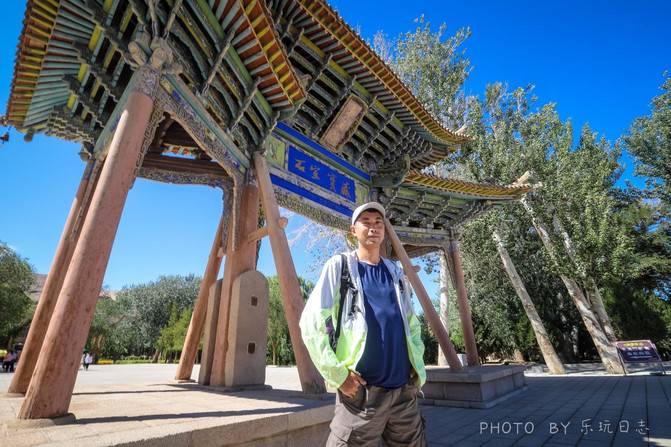
Now, if you go back to the city from Dunhuang airport, you will pass an ancient city, which was the location of Dunhuang film.
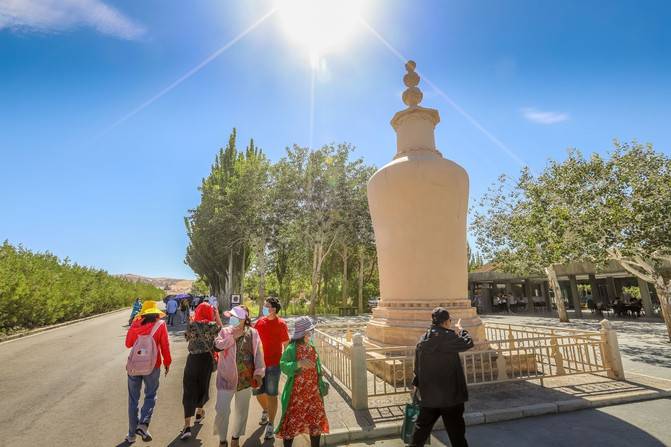
After Dunhuang was abandoned, no new caves were opened in the Yuan Dynasty. In the Ming Dynasty, Dunhuang was closed outside the great wall of Jiayuguan. Dunhuang became a place beyond the Great Wall, a nomadic land for nomads.
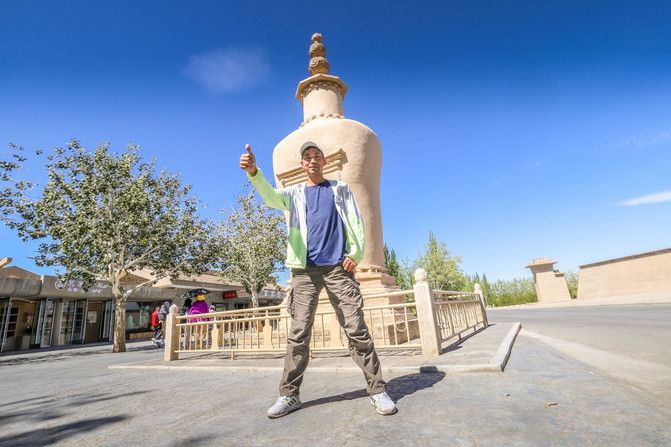
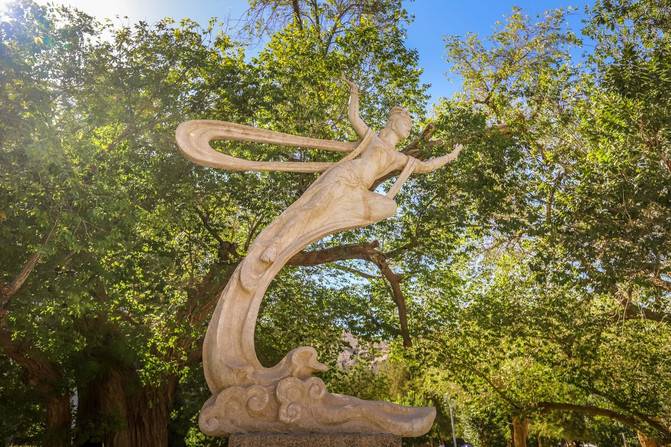
Go on, there is a flying statue under the tree. She is showing a beautiful dancing posture. Feitian is the immortal flying in the air in Buddhism. Generally, when Bodhisattvas preach, Feitian will appear around her to scatter flowers or dance for her. In many subsequent Dunhuang mural works, we can see flying statues, including the city sign in the center of the street when we just entered Dunhuang City, which is also a flying statue reflecting pipa. I witnessed the exquisite murals. There are 735 caves in the whole Mogao Grottoes, of which only 60-70 are open to the public. When you enter the Mogao Grottoes, you will be awed by all these things in front of you. You will be absorbed in every inch of the mottled stone wall.
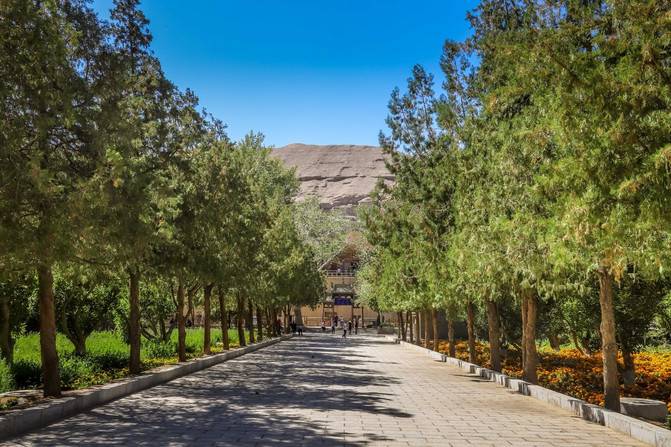
There are 735 caves in Mogao Grottoes. There are a lot of murals and clay sculptures in the caves. It is the largest and most abundant art place in China and even in the world. There are class A, class B and class C tickets. There are also some special cave exhibitions. We bought the most suitable class B tickets, and we can see four of them.
In the whole Mogao Grottoes, they are basically primitive caves dug along the mountain wall.
In order to prevent air from entering and oxidize the murals, the guide will lock the door before leaving.
The nine storey building is the first cave to be visited with class B tickets and the last cave to be visited with class a tickets. As the name suggests, the pavilion is a nine story wooden structure. The building in front of the cave was rebuilt in the Republic of China. The original Pavilion had only four floors, and it was rebuilt in successive dynasties. The last one was completed in 1935.
The cave was excavated during the Tianbao period of Kaiyuan (713-742 A.D.) in Tang Dynasty. Maitreya, the "successor" of Sakyamuni, is worshipped in the cave. Therefore, people call it the future Buddha.
It is said that the face of the Buddha was built according to the prototype of Wu Zetian. It is round and full in shape, quiet and graceful. The whole Buddha statue is 26 meters high and 12 meters wide between two knees. Visitors stand at the foot of the Buddha and look up. The Giant Buddha is magnificent and is the second largest Buddha in Mogao Grottoes.
The feet of Buddha are very big, and the nails can be seen clearly, which is in line with the aesthetic art of the Tang Dynasty.
The murals in the grottoes were redrawn in the Song Dynasty and are also very exquisite. Then the murals left at the entrance are said to be the original works of the Tang Dynasty, but now they are faded and can't be seen clearly.
The statue of Buddha Sakyamuni's nirvana is worshipped in the reclining Buddha grottoes. The reclining Buddha in the Grottoes is 15 or 8 meters long. It has a very beautiful shape and a serene look. It represents the Buddha's nirvana when he was free from reincarnation and passed away.
The small statues behind the reclining Buddha express the different states of Sakyamuni's disciples when they saw the Buddha's passing away, with different faces and expressions.
The murals on the top of the cave are very gorgeous. There are countless small Buddha portraits in front of our eyes. Just think about how much time it takes for painters to paint such beautiful images in this small space.
The paintings on the outside of the cave are much simpler, and the colors are not as bright as those on the inside, which may be the reason for long-term exposure to the air and oxidation.
After watching, the guide locked the door of the cave again.
In 366 A.D., monk Le Fu opened the first Buddhist niche in Dunhuang Mogao Grottoes. After 1650 years of construction, these historical paintings across time and space have become world cultural heritage. Together with Yungang Grottoes in Shanxi Province and Longmen Grottoes in Henan Province, Mogao Grottoes are also known as the "three art treasures of grottoes" in China.
So, how was the Mogao Grottoes excavated? Why does the mural in it last for thousands of years? How to make and build the tall Buddha statue?
With these questions, I went to the Dunhuang Grottoes cultural relics protection research exhibition center to find out. 1、 Geological environment Mingsha mountain, where Mogao Grottoes are located, is dry and rainless all year round, which provides a good external environment for the preservation of stone carvings, murals, painted sculptures and other cultural relics. 2、 The pigments on display in the Dunhuang Grottoes museum are all made from natural ores. Through the procedures of material selection, crushing, iron removal, research, bleaching and grading, various colors suitable for painting are produced.
Its color is pure and thick, gorgeous and not vulgar, with weather resistance, light resistance, not afraid of acid and alkali corrosion and other characteristics. Even if it has not been in the soil for many years, it will not affect its brilliant color, which has the performance effect that chemical synthetic pigment is difficult to achieve. Secondly, the use of animal glue, which is a mineral color binder, cleverly bond the mineral color of the particles, different colors of pigments superimposed, resulting in a unique color effect of mineral color, so that the picture presents a variety of color charm.
All the caves in Mogao Grottoes are the comprehensive art of painted sculpture, architecture and painting. From the beginning to the completion of a cave, there are a series of construction procedures, such as renovating the cliff surface, chiseling the cave, drawing mural statues, building and decorating the eaves or halls. At the beginning of the cave construction project, there was a detailed division of labor. There are mainly the following types of craftsmen involved in the construction of caves: 1; 2. A craftsman who is engaged in the excavation of grottoes, the processing of building stones, the manufacture and repair of stone tools, etc; 3. A craftsman engaged in civil engineering; 4. Carpenter is a craftsman engaged in the manufacture, processing and repair of civil engineering and wooden utensils; 5. The sculptor is engaged in painting clay sculpture; 6. A craftsman engaged in painting.
The Mogao Grottoes museum also displays relics related to the Sutra cave, including copies of Dunhuang manuscripts and paintings lost abroad.
There are manuscripts and engravings on display. The contents of the documents are mainly Buddhist scriptures, as well as Taoist Scriptures, Confucian classics, poems, letters and certificates. These are very important research values for scholars, especially for learning ancient Chinese history.
The sculptures in the caves are also exquisitely made. Although they are all copied caves, they are rich in color restoration, and the figures of Buddha statues are quiet and serene. From these art treasures, we can see some of the religious and social life in Medieval China.
It can be imagined that this huge painting project must have exhausted the energy of many painters. It takes people to stay in Dunhuang and contribute their whole life to achieve this artistic achievement, right?
The painted sculptures and frescoes in Dunhuang Grottoes are extensive and profound, and most of them are Buddhist: the statues of painted sculptures and frescoes, Sakyamuni's Bunsen, Buddhist stories, Buddhist historical sites and other story paintings are all painted in the four walls, cave tops and niches of the grottoes.
The picture above shows the story of offering sacrifices to Buddha.
In addition, there are some paintings that show hunting, farming, weaving, construction, dancing, weddings, funerals and other aspects of social life at that time. If you look at the portraits carefully, the costumes of the characters can reflect the characteristics of people's clothing in different periods.
The murals in Dunhuang Grottoes can reflect the social life and customs of that time. For example, the hair of the three people on the right looks like that of an alien nationality.
These are the carved floor tiles buried in the cave.
This is the four steps of building a giant Buddha. They are to make a bracket of wood, then tie straw on it, but cover it with mud, and finally carve and color it.
The material of Mogao Grottoes, Shiqing No. 3-14, is grinded with lapis lazuli. The Dunhuang murals and statues are grinded with mineral pigments, which are rich in color and strong in expression.
Recommended Taxi: take a taxi from the urban area to the digital exhibition center about 9 km. Bus: please go to the opposite side of Yiyuan Hotel on Silk Road and take bus No.12. We went by charter. Scenic spot address Gansu Province - Jiuquan City - Dunhuang City - near 314 provincial road
Visit tips: the Mogao Grottoes are divided into category A, category B and category C. category A includes 8 caves, category B includes 4 caves, and category C includes only digital movies. To visit the Mogao Grottoes, you must make an appointment in advance, show the "Health Code" and wear a mask during the whole visit.
Oil town
Dunhuang travel guide, "nine story demon tower" shooting place, Akesai oil town, our Qinggan big ring road, through the second scenic spot in the itinerary, is Akesai oil town.
Oil town is the wanghong scenic spot on the Gansu Qinghai ring road. After paying 20 yuan ticket, you can enter this "ruins" creation tour.
The oil town is built on a vast flat land with many weeds;
Many Adobe houses have collapsed, and most of the existing brick houses have been demolished, leaving some door frames fragmented and incomplete.
The roads in the small town are straight and neat, but the streets are lifeless and full of decadence. I know Shizhen town from the movie "nine story demon tower". In the movie, it is said that the town was attacked by monsters in 1985, and people in the town were killed before it was abandoned.
With curiosity, I found out the real reason why the town was abandoned. The reason is that the natural environment in Northwest China is too bad, because it is mainly for exploiting resources. As time goes on, the oil resources are gradually exhausted, and when the oil fields fall into the development trough. After the exploitation of resources, the oil town lost its value, and it was short of food, so it was abandoned directly.
What do you want to play in the ruins of oil town? Of course, it's the location of punch in movies. The abandoned town has become the location of many movies, such as "the west wind" and "the nine story demon tower" are all created here. Walking through the old cinemas, government buildings, hospitals, kindergartens, ancient prison sites and other buildings, you will gain a sense of loneliness that you rarely have a chance to experience.
Photography is the best way to experience the ruins of an oil town. The town as a whole retains the flavor of the 1980s in China, and is also suitable for taking photos. Everywhere a shot, is a kind of dilapidated and waste atmosphere. You can make some industrial style, eschatological style, cool blockbusters. Maybe this is the beauty of decay brought by the passage of time.
On the building, there are a lot of monster props used in previous movies. They are wrapped with iron chains and have long tusks in their mouths. They look a bit scary.
In the 1980s, the advertising version of motorcycles.
The maps in the government building, made of ceramic tiles, have not faded for so many years.
In the nine story demon tower movie, the theater was attacked by a monster.
There are shops in the town, and the nine story demon tower is inserted upside down into the bus on the main road. In addition, there are airplanes, tanks and jeeps on the ruins of the road, which are good creative backgrounds.
If you want to shoot the industrial style, you can look for the factory building in the back. There are five big words on the tall wall: safety and production promotion. There is also a bus stop ahead.
Road signs on route 16 in Mexico, USA.
Travel tips: navigation: choose the location of "BOLUO zhuanjing", or Aksai oil town, the parking fee is 40 / car, and the ticket is 20 yuan / person
Eboliang Geopark
In the distant days of outbound travel, we can only wander around at home. As a result, many popular scenic spots in China have been developed one after another.
see? Today, I'd like to take you to punch in. This scenic spot is the No.1 wanghong on Gansu Qingda ring road. Many netizens praised as "the most Mars like place on earth" - Qinghai Lenghu Eboliang Geopark.
"Eboliang" is the name given to it by the local people. This is a Mongolian language, which means "OBO" and "Tudui" in Chinese. This word is easy to understand from the shape, that is, in a vast land, there are many mounds of earth.
This is true in reality. Only when I have been to Eboliang can I really feel the desolation of the northwest.
There are sometimes strong winds in this place. Whenever the vehicles pass by, high dust will roll up behind them; From a close view, there is no grass on the land. From a distance, the Gobi desert will shine brightly in the sun. When you get close to it, you will know that it is one after another of alkali salt crystals reflecting the sunlight. So long-term lack of water, plants can not survive here.
According to geologists, the desolate "oboliang" is the most Mars like place on earth.
Eboliang Geopark is on the provincial highway s305, which is a no man's land, so there is no admission to the park.
There is no asphalt in the whole park, so we can only follow the track of the car in front.
The place with good scenery is in the earth forest. The more you open to it, the more unique the scenery is. It's all landscapes that we can't see in our daily life.
We chose one of the higher earth bags to climb up, and we can see the whole Yadan group.
The earth bags are like aircraft carriers in the vast ocean. The types of single Yadan in Eboliang are very rich. In addition to the soil bag of turtle back type, there are many kinds of shapes, such as trough ridge type, beacon type, column type and so on.
The dense beacon type earth bags look like thousands of troops in the battlefield, and the unique scenery is amazing.
Although I haven't been to the ghost city in Xinjiang, the peak cluster shape of Eboliang Geopark is definitely a good natural Yadan landform Museum in China.
The uncanny workmanship of nature left such magical lines to oboliang. It's super beautiful!
Travel tips: Address: Eboliang Yadan Landform Scenic Spot, Haixi Prefecture, Qinghai province admission: Free Photo introduction: like all scenic spots, the prime time for shooting is half an hour before sunrise and sunset. And the galaxy is the most beautiful. A deserted place is the best place to watch the stars. Many car advertisements are shot here.
Note: first, after dark, it's very easy to get lost when driving or walking on Eboliang, because there is no official road in the scenic area, so the navigation is also unavailable. 2、 In the Yadan group, there are the same earth bags all around. The view is not far. There is no reference to determine the direction. There are basically no road signs. The whole Gobi desert is full of ruts. Although the sunset is beautiful, it is very difficult to go out if you don't live here. 3、 Don't leave the subgrade easily. It's easy to get stuck because there are many ruts. We wanted to save the distance and chose a near rutting. As a result, we got stuck after a long walk. Fortunately, we were able to escape along the original road in time.
Aerial photo of the Mars camp in Eboliang, the largest Yadan group in the world, is breathtaking. In the depth of Qaidam Basin in China, there is a sudden uplift of wind erosion soil forest group, with a total area of 20000 square kilometers. This is the largest wind erosion soil forest group found in China, and also one of the largest and most typical Yadan landforms in the world.
According to the expert's research, the formation of this wind eroded soil forest group is due to the uplift of the ancient sea bed after the Himalayan orogeny. After the sea dried up, it was constantly eroded by the wind, forming the present Yadan shaped landscape of turtle back, dome, column and trough ridge.
Eboliang, a no man's land, is full of soft sand at any step. There is a lot of dust in the soil layer, and there is not a single grass around it. It is known as "the most Mars like place on earth".
What's more interesting is that people here have built a "Mars camp", which provides accommodation and meals. The layout is arranged according to the structure of the astronaut's space station, and the sleeping module looks like the plot in the movie.
However, after inquiring, the price of accommodation here is quite expensive.
The biggest advantage is that this is the only hotel in Eboliang Geopark, and at night, you can see the whole galaxy across the sky with your naked eye.
Because there are no towns within 70 kilometers of oboliang, and there is no light pollution, it is an excellent place for China to watch the starry sky. In the evening, you can use the Yadan landform of Eboliang to make the foreground + the big galaxy. No matter the photos or videos, they are super shocking.
Travel tips: Mars No.1 camp address: Eboliang Yadan Geopark, Haixi Prefecture, Qinghai Province transportation: after seeing the billboard of "Eboliang Yadan Geopark" on national highway 315, turn to the dirt road and follow the mark of Mars No.1 highway. The camp provides accommodation and meals
Features: there are some balance instruments outside the camp, which are usually used by astronauts for practice. Tourists can feel them by themselves. The Mars camp is also the first Mars simulation base in China, where children can have popular science education, such as watching the stars and roaming in space. By cultivating children's interest, it lays the foundation for future scientists.
Photography lovers, if you shoot the starry sky, you must shoot it before the moon comes out. Even if it is a full moon, you can also shoot a beautiful starry sky. Creative photography, you can buy a space suit or night fluorescent suit on a treasure to make photo props, so that you can take photos different from the public.
On the way, I happened to travel by setting up a stall for Xiaofen. The price of food in the stall was almost the same as that in the urban area. In no man's land, the price was quite conscientious. I quickly added some food.
Talk about Qinghai's wanghong punch in place - Mangya feicui lake. Although it is not as famous as Chaka Salt Lake, it is composed of lakes of different sizes with Hami melon like texture, which is not found in other salt lakes. So the beauty of Qingche is the paradise that we photography lovers are looking for.
Mangya feicui lake is the mining area of Salt Lake in Dachaidan chemical plant. There is no tourism development now, so tickets are not charged for the time being.
The color of Mangya Emerald Lake is related to the mineral concentration in the lake. There are a lot of magnesium and potassium in the lake water. When the water evaporates, the lake water will become crystal clear. Especially when the sunlight comes out, the color of the lake is as beautiful as emerald.
It is understood that the Qinghai Tibet Plateau was an ancient ocean hundreds of millions of years ago. Later, after the crustal movement, the ground uplift and sea water evaporation, the salt in the original sea water remained. In some low-lying areas, many salt lakes were formed, and Mangya feicui lake is one of them.
Photography suggestion: it's suitable to choose some bright clothes. It's easy to make a big film. The sun at noon is the best, and the color of the salt lake is also gray. We were a little disappointed for a time. After waiting for more than an hour, everything became beautiful when the sun rose.
Photo attention: the light of feicui lake is very strong. When flying UAV, it is recommended to change the dimmer to avoid overexposure. Or turn HDR mode on.
On weekends, there are red mountains like this. The snow mountains below are Kunlun Mountains.
The white one is salt
Lying on the salt lake, you can take a glass boat, 50 yuan per person.
The salt lake is so big that it takes 15 minutes to drive around.
Feicui Lake tips: traffic guidance: at present, there is no bus to the scenic area, at present, we can only drive to the scenic area, we charter a car to the scenic area. Free tickets for all day opening hours scenic spot address in the Salt Lake mining area of the former Dachaidan chemical plant in Haixi Mongolian and Tibetan Autonomous Prefecture of Qinghai Province suggestions: when you play, you are not recommended to go into the water, because the salt content is very high. If your skin touches the salt water, you will immediately get a layer of white salt. Accommodation: there is no hotel near feicui lake. The nearest town is Dachaidan Town, where the accommodation conditions are OK.
Northwest loop self driving tour, magic Mangya Aiken spring, like the eyes embedded in the earth
Northwest China is a very magical place. In this barren land, there are many little-known beautiful scenery. During our 8-day self driving, the scenery every day makes people marvel at the beauty of nature, so it's right to go far to have a look.
On the fourth day, you will arrive at Mangya. In addition to feicui lake, there is Aiken spring, which is also a local must punch in scenic spot.
Aiken spring has many titles, such as "eye of the devil", "eye of Qaidam" and "eye of the earth", which are the most vivid descriptions of this magical spring.
The real reason is that the sulfur content in the "Aiken spring" is too high. After long-term evaporation, the soil around the spring will be permeated with precipitated minerals, which will destroy all the surrounding vegetation and soil. If animals drink this water, they will die of poisoning.
Aerial photos show that in the middle of the flat, vast and vast land, there is an oval spring with a diameter of 10 meters. There is boiling water in the middle of the spring, which keeps rolling and surging. The color is very beautiful.
The magic of AI Quan eye lies in the fact that when you look down from the air, you can find the central spring eye and the deep red ring like deposits around it, which form a unique pupil shape, just like the eyes embedded in the earth.
Next to the spring, the herdsman's manidui is praying.
The local herdsmen specially built a simple iron frame viewing platform, which costs 10 yuan to get on the viewing platform.
Because the spring water is corrosive, the local herdsmen's water pipe has built a temporary bridge for tourists to facilitate passage.
There is no grass around the spring, but 800 meters away from the spring, you can see the green plants growing on the salinized land. Notice that the white one is not snow, but a crystal of salt.
In the distance, you can see the towering Kunlun Mountains, covered with white snow, which is very spectacular.
G315 road is OK, from the intersection to the scenic area, is a 30 km long gravel road, the road is not easy to walk, the road is narrow, you should be very careful.
This is the entrance of the scenic area of AI Quan Quan. The scenic spot is free. You need to get off the train to show your itinerary code and register the license plates and personal ID number.
Note: after leaving G315 National Road, the scenic spot still needs to walk 30 kilometers of dirt road, which is very difficult to walk. There is a safety line in the spring, but it can walk outside. The soil is brittle. Eye of the devil, aerial photography effect is good, but aerial photography must be looking at their own UAV to fly, otherwise it is easy to crash, visible to the naked eye on the scene, at least 20-30 UAVs take off at one time. Transportation: no public transportation, only suitable for self driving. Starting from Mangya to Xinjiang along G315 national highway, you can see the signboard pointing to aikenquan after you leave the checkpoint of Qinghai Province. You can walk another 30 kilometers along Tu road to reach the destination. Opening hours: 9:00-18:30 address: Huatugou Town, Mangya City, Haixi Mongolian and Tibetan Autonomous Prefecture, Qinghai province admission: free
Along the way, you will see many oil wells on both sides of the road, which are part of Qinghai Oilfield.
Behind the oil field is the vast snow mountain.
The Emerald Lake in Dachaidan, Qinghai Province, is an emerald left in the world. It's mysterious, low-key and free of charge
Compared with Mangya feicui lake, Dachaidan feicui lake has larger area and richer colors. Another advantage is that it is only 10 kilometers away from Dachaidan Town, and the road is very easy to walk. It's only 10 minutes to drive to the scenic spot, which is very convenient.
The scenic spot is the mining area of Salt Lake mining team of Dachaidan chemical plant. Before entering the scenic spot, you can see the big slogan of the plant.
There is a parking lot and a toilet in the scenic area, from the signboard to the red glass boat, so this is the best facility in Qinghai Salt Lake scenic area.
You can feel its beauty in many ways, and aerial photography is still the first choice, because the salt lake is particularly spectacular under the aerial view.
Countless broken emeralds are divided into dozens of lakes, large and small, and inlaid on the earth.
There are continuous snow mountains not far away. When there is no wind, the calm lake is like a mirror, reflecting the blue sky and suspended white clouds. It's really beautiful.
The tour route is a clockwise circular route. When you enter the gate, turn left, follow the road and drive along the lake. If you see something nice, you can park on the side of the road.
There are many types of salt lakes here. The most popular one is the "heart-shaped Lake". It is covered with dark brown land, surrounded by white salt crystals, and the light green water is in the middle. It's super beautiful to lie beside it and take pictures!
This lake is the last exit. When you see the red spire, the first 60 meters stop is the heart-shaped lake.
Salt Lake knowledge: continue to talk about the formation of salt lakes. 200 million years ago, the Qinghai Tibet Plateau was still a vast ocean. After the Himalayan orogeny, the sea bottom uplifted up and became the Qinghai Tibet Plateau. In some low-lying areas, the sea water gathered here, and the sea water faded and evaporated, forming salt crystals and depositing in this area. Modern people will develop the metallogenic area here. These lakes, large and small, are the mines left by the workers after mining. Because the salt content in the mine is different, the lake water can show different patterns, joints and colors. And whenever the sun shines, the light will penetrate the lake, the density of the lake is different, and changes into different colors.
The most beautiful photography time in the scenic spot is at noon, when the sunshine is the most, and there is no shadow in aerial photography. There is also the setting sun, which is said to be very beautiful, but the relationship between time, we can see.
There is no light pollution around, so it's suitable for shooting the starry sky, especially for the super positive delay video. We didn't dare to insist because of the strong wind at night, so we went back to have a rest.
Travel tips address: Dachaidan feicui lake, Haixi Prefecture, Qinghai Province (about 10 kilometers away from Dachaidan town) opening hours: 9:30 a.m. - 17:00 p.m. traffic guide: navigation destination: Dachaidan feicui Lake admission: free public transport: not available, most suitable for self driving.
In this northwest self driving tour, we clocked in four wanghong lakes, namely, Dongtai jinaer lake, Xitai jinaer lake, Dachaidan feicui lake and Mangya feicui lake. The four lakes are unique, and the more magical one is Xitai jinaer lake.
What's special about the lake is that it's a two-color lake. It's not obvious on the ground, but if you put the UAV in the air to look down, you will be surprised to find that the plain lake is divided into two parts by the road, one is green, the other is emerald green, which is very magical!
The reason why the lake is so magical is that it is mainly affected by pluvial, alluvial, aeolian, lacustrine clastic deposits and some salt chemical deposits. It belongs to magnesium sulfate sub Salt Lake, in which lithium resources are particularly abundant, and lithium is also the raw material for making lithium batteries.
It's very convenient to punch in the lake, because national highway 315 passes through the lake, and there is no specific scenic spot on the lake. If you see the right one, you can park your car on the side of the road.
There is no asphalt and cement on the road surface. It's all loess road. When cars pass by, smoke and dust will roll.
Is the silhouette of the setting sun beautiful?
The two-color lake looks the same color as the sea. If I don't tell you about Qinghai, just look at the photos, you must think it was taken at the seaside.
Caixia flies with wild ducks in the sunshine. Do you have a Tang poem "sunset and lone ducks fly together, autumn water grows in the same color in the sky?" What's the artistic conception of?
Travel tips: Address: member of the administrative committee of Dachaidan, Haixi Mongolian and Tibetan Autonomous Prefecture, Qinghai Province transportation: Shuangse lake has not been developed by tourism, so the traffic is not smooth, so you can choose to charter a car to carpool or drive by yourself. Best time to take photos: sunset is the most beautiful time on the lake, but I didn't take pictures of the beautiful scenery at that time because the UAV had no power. Although the lake is a salt lake, there are still many water birds living here. In the evening, they fly in groups, and the scene is spectacular. Admission: free accommodation suggestion: after crossing the bridge, it's Yadan B & B on water. Basically, all Yadan playing on water will stay here for one night. The accommodation conditions are poor and there are few rooms. The best room is the container, and the cheapest is the tent. The front desk of B & B is a supermarket, which can supply some food and water. However, it is difficult to take a bath, mainly due to the shortage of fresh water resources. There is no independent toilet in the room, and the public toilet is used, which is not too clean. WiFi is available. It takes more than 300 nights to live in containers, but considering that there are no man's land nearby, we can only make do with it and live here. Suggestions: the gap between the three scenic spots is not far. Just arrange to experience them in the same day. There are no tickets for the two lakes. Yadan scenic spot on the water charges 120 yuan, which is quite expensive.
Take the most beautiful highway 315 to meet the beautiful scenery and continue to explore the beauty of the northwest. In China, there are several national highways that you have to punch in all your life. For example, the 318 National Highway from Shanghai to Tibet has been there three times. This time, Gansu Qingda Ring Road chose 315 national road which was praised and worshipped by many netizens.
315 Chinese mainland Road end was only a red road last year. Its starting point is Xining, Qinghai Province, with the end point being the most western part of mainland China, Xinjiang Kashi, which is 3063 km long.
The most beautiful section of national highway 315 is the U-shaped highway across the desert, because the highway is built along the undulating terrain of the desert. I think the most shocking scenery is the uphill section, because it looks like the highway is vertical and upward, just like climbing to the sky, which is very unique.
The shape of highway 315 is very good, and it's all asphalt, and the road is very clean.
UAV in the air, like a huge black Wolong, lying on the golden sand.
Driving on the straight 315 national highway, the windows are completely empty except for yellow sand, revealing the desolate atmosphere of desert everywhere.
Every day when I travel in Northwest China, I feel my eyes are in heaven. We drive through one no man's land after another, through Qaidam, looking at the unique Gobi desert here in China, and the harvest is full.
When I went there, it was already September. I still saw so many people coming to punch in. They opened the window and looked out to enjoy the most beautiful national highway.
With people waving their hands on the scarves, to us.
In the distance of the desert is the towering snow mountain. It is said that the air gap in the desert is very big. It is not suitable for human beings to live here, but we can see that animals can still live on it, such as wolves and camels.
Climbing up the top of the mountain, you can see the boundless loess.
The one behind the car is Altyn hill.
Panorama of 315 national highway, desert is not invariable, they will move with the wind, changing the shape of their dunes.
XIAOCHAIDAN Lake beside 315 national highway, today's weather is good, weather visibility is high, you can see the other side of the lake, there are continuous red mountains,.
We stayed in Dachaidan town in the evening, and then went to Dachaidan feicui lake the next day.
Northwest tourism must go to scenic spots, water Yadan, the formation of the reason is actually like this
In the beautiful Qaidam Basin in the northwest, there is a unique scenic spot in the world, which is the magical water Yadan Geopark.
The full name of Yadan Geopark on water is wusut Yadan Geopark, "Yadan" is translated into steep hillsides in local Uyghur language.
If you look around, you can see that on the blue water in the distance, there are islands as long as warships, which are reflected with the endless lakes and Gobi desert, forming an amazing beauty.
How did this shocking landscape come into being? According to expert research, it may be that the global temperature is rising, the thermal effect makes the surrounding snow mountains melt, and then the lake surface area expands. The original wind erosion soil forest group was inundated before the magic landscape of Yadan on the water appeared.
The earth forest in Yadan Geopark can be climbed up. You can see that there are no plants growing on the mound, which is the most primitive natural style.
The whole water Yadan peak forest is densely covered with different shapes, mostly strip-shaped, but also oval shaped. Standing on the top of the earth forest, you will feel that the heaven and earth are big, and people are very small. UAVs can highlight this powerful momentum.
Walking along the lake, you can see some water birds living on the quiet lake, which is also their natural habitat.
Travel tips: Address: beside 315 National Road, Haixi Mongolian and Tibetan Autonomous Prefecture, Qinghai Province. Transportation: whether you go to Haixi line or Qinggan Ring Road, you will pass this scenic spot. It is more than 260 kilometers away from Dachaidan town on Liuge Expressway and Xisha line. Ticket: including 120 people on the shuttle bus. One photographer suggested that you should take pictures on the UAV, otherwise you can't express the shocking momentum.
Accommodation suggestions: there is a RV camp in the scenic area. You can rent a car to experience the fun of RV life. There are independent toilets, TV, WiFi, etc. in the car. For accommodation conditions, it should be the best nearby. The advantage of living here is that you can see the dazzling starry sky by pushing the window, which is also super beautiful.
After thousands of years of geological movement, Yadan landform area on the water can give birth to this spectacular wind erosion soil forest group in Yadan.
Dongtai jinaer Lake
Northwest tourism has a must punch point, which is hidden in the secret place of no man's land in Qaidam. The good thing is the Dongtai jinaer lake, which is known as the "Maldives" in Qinghai.
The most special feature of Dongtai jinaer lake is that its water color is Tiffany blue and clear; It looks like the sea water of Maldives, a popular island destination.
When you can't travel abroad, it's good to come to the northwest to see the Qinghai version of "Maldives".
The jinaer Lake in Dongtai is more beautiful than you think. With its boundless water and white beach at your feet, it's like going to the seaside for a holiday. Jumping on a glass boat to take a picture again is totally "pretending to be on the island".
Dongtai jinaer lake is a free scenic spot. In fact, it is a chemical and mineral area in Dachaidan town. The lake is a magnesium sulfate salt lake, and the lake water contains a lot of lithium, potassium, magnesium and other resources, which are one of the important industrial raw materials.
Compared with Chaka Salt Lake, another wanghong "sky land" in Qinghai Province, jinaer Lake in Dongtai will be more primitive, less commercialized, and less tourists. At present, it is still a secret place for the minority.
The East taijinaer lake, the West taijinaer lake and the water Yadan were originally connected. Later, because the lake dried up, it gradually separated.
Salt lake and salt beach. Look at the silver beach formed by the salt on the bank. There are no animals or plants in the whole lake area.
Viewing platform, you can take photos.
Before entering the scenic area, you will pass this dirt road.
The safety notice in the mining area reminds tourists that although the lake water is very clear and transparent, it can not be used up in the water because the water is a solution of magnesium chloride crystal.
When it comes to stone forest, you may first think of Kunming Stone Forest in Yunnan. In Jingtai County of Northwest China, there is also a Yellow River Stone Forest in Jingtai County of Gansu Province, which can be mentioned as well as Yunnan stone forest.
The Yellow River Stone Forest scenic spot is located in the southeast of Jingtai County, Baiyin City, Gansu Province, covering an area of 10 square kilometers. The stone forest landform is rare in China and unique in Northwest China. It can be called "China's natural wonder" and is selected as the most beautiful northwest 100 scenic spots.
When you first saw the stone forest of the Yellow River, you were immediately shocked by its magnificent sight. The stone forest and the Jiuqu Yellow River are linked together. The towering mountains are cut into deep gullies one after another. The peak forest here is full of loess color, rough, vigorous, simple and heavy, showing the characteristics of the West.
The gate of the scenic spot is at the top of the mountain. We need to take the sightseeing bus to the bottom of the valley, and then transfer to the battery car to continue the tour. During the tour, we can also take the sheepskin Feller to experience the drifting of the Yellow River. The most unique thing is to take the mule car with northwest style in the canyon.
Compared with other well-known scenic spots in China, the Yellow River Stone Forest scenic area has more meandering canyons, towering peak forests, various overhanging rocks and cliffs in the air, magnificent and natural shapes. People also give them various good names, such as "elephant absorbs water", "goddess looks at the moon" and "lovers under the moon".
The order of our tour is to park the car in the parking lot, then go to the ticket office in the picture above to buy tickets, and then walk to the bus station to take the bus down the mountain.
The entrance of the scenic area is modeled as a stone forest.
There are also murals in the Yellow River Shilin National Geopark, on which the ancients lived by the Yellow River.
After going down the mountain, the first scenic spot is Panlong cave, a fairyland on earth.
"Panlong cave" is hidden in a canyon in the stone forest. It is a temple. There are some Taoist relics in it.
The floor of Panlong cave has been paved with smooth floor tiles. It's very comfortable to walk.
Both sides also planted a lot of green plants, and green bamboo and so on, very eye-catching.
The main gate of Panlong cave is carved with two golden dragons and a stone lion on each side of the gate.
At the entrance of the cave, there is a stone tablet with gold characters on a blue background, engraved with a brief introduction of Panlong cave, which says that Panlong cave was built in the first year of Jiaqing in the Qing Dynasty.
Panlong cave has two floors. The above picture shows the ground floor of the main entrance, in which there are statues and shrines.
When you enter the cave, you look up and see a pure natural Tai Chi diagram on the top of the cave. It says that the dragon and Phoenix are auspicious. Do you see it?
Looking at the picture carefully, I'm going to the underground floor of Panlong cave to find out.
As you can see, the underground floor is also filled with statues and shrines.
The light inside the cave is relatively dark, and the temperature is obviously several degrees lower than that outside. It is said that Panlong cave was built in the Qing Dynasty because the local people often saw fog floating out of the cave when they passed through the cave. It was called Xiandong because it was like the immortal spirit of Longkou. Later, a Taoist built a temple in the cave, which formed a religious place, and the people nearby would come to burn incense during the Spring Festival.
Aerial photography of the Yellow River Stone Forest shows that the oasis area under the Yellow River stone forest is quite large, which is in great contrast to the desolate stone forest.
Behind the Yellow River in this turn a big bend, and the river, there is a green sandbank island.
The stone forest blends with the Yellow River, oases and villages, and has the charm of a large natural garden.
When going down the mountain, Panshan road is narrow, with many 180 degree sharp turns.
The roads are built along the cliff. With the decrease of the sea level, the scenery outside the car window is more and more beautiful.
The air overlooks these deep gullies cut by running water.
Came to the Yellow River embankment.
Travel information: Address: Longwan village, Zhongquan Township, Jingtai County, Baiyin City, Gansu Province. Opening hours: 07:00-18:00. The ticket price is 125 yuan per person (including tickets, shuttle bus, battery car and one-way Cruise). It is recommended to visit the scenic spot for half a day. The transportation distance from Lanzhou airport is 160 km. We are self driving and can get to the scenic spot in 2.5 hours from the airport.
Yongtai Guicheng
The last turtle city in the world, which was left deep in the northwest Gobi, used to be the scene of popular movies
In history, Lanzhou used to be the forefront of farming civilization and nomadic warfare. At that time, the Ming dynasty built the Great Wall specially to defend against the invasion of nomadic people in the north. Yongtai turtle city is a castle built because of the war. It is located 27 kilometers southwest of Jingtai County, Gansu Province. Because its castle looks like a golden turtle, it is called Yongtai turtle city.
Yongtai turtle city's ancient city is an oval, surrounded by four urn, the shape of the shoulders and feet of a golden turtle.
The castle has a history of more than 400 years. It is still well preserved, but the wooden buildings on the urn have been destroyed. Now there are traces of some moats, beacon towers and other military facilities left behind. We can still see the momentum of being a military fortress at that time.
Guicheng, Yongtai, is an ancient city disappearing slowly in Northwest China. It is surrounded by Gobi semi desert. Natural vegetation is b
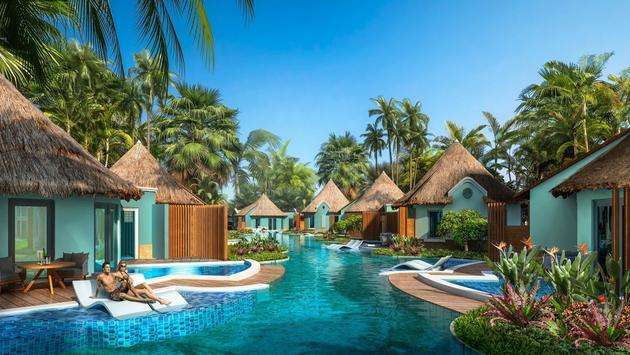
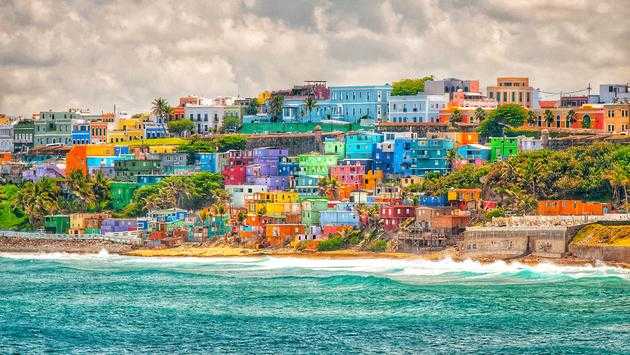
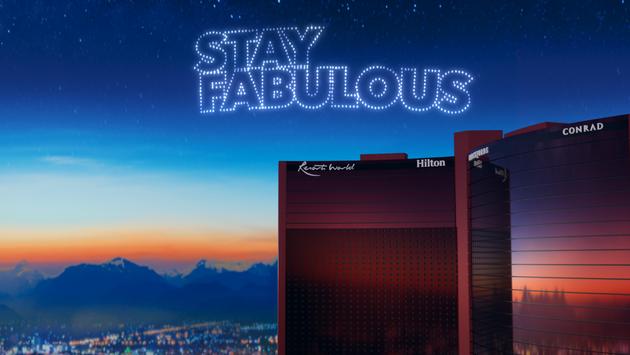

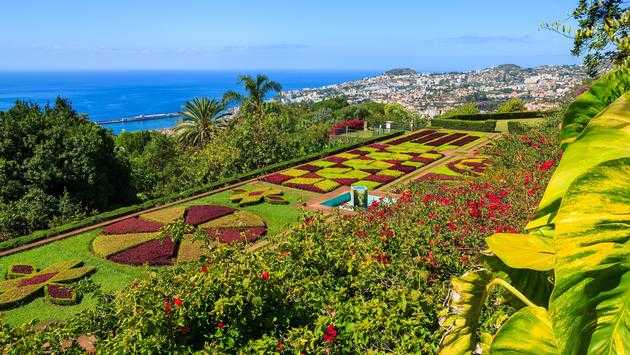
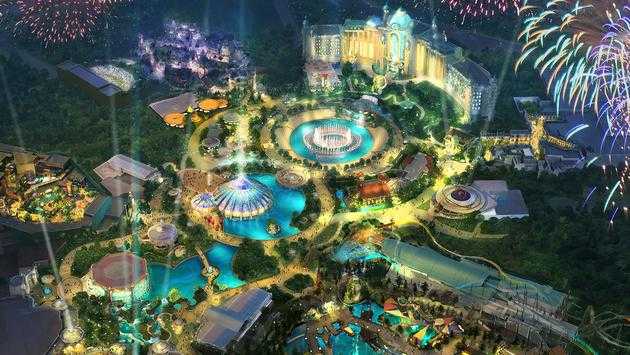
Leave a Comment